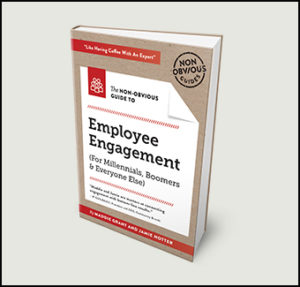The Surprising Secret to Improving Employee Engagement
Eighteen years ago, the Gallup corporation did some research on a hot “new” topic—employee engagement—and reported some distressing numbers. According to their surveys, only 30 percent of the workforce was considered “highly engaged.” We all know what a highly-engaged employee looks like—they are focused, energetic, and they give their full commitment and “discretionary effort” to the job. They do good work, and they go the extra mile. It feels good to be working alongside people like that.
Yet less than one-third of employees fall into that category. Obviously, that caught our collective attention, because over the last 18 years we have suffered through thousands of employee engagement surveys and created untold number of internal task forces responsible for increasing engagement. In 2012, Josh Bersin and his colleagues at Deloitte estimated that the annual spend on employee engagement was nearing $1 billion, on its way to a projected $1.5 billion annually.
But here’s the really shocking part: after 18 years and literally billions spent trying to improve engagement, American companies have only managed to move the needle by four percentage points (34 percent highly engaged in 2018). That return doesn’t quite feel worth the investment. In fact, at the current rate, it will take more than 300 years to reach 100 percent engagement.
So, why are we spinning our wheels? That was the question Maddie Grant and I attempted to answer in our latest book, The Non-Obvious Guide to Employee Engagement. Based on our research and experience with clients, we came to the realization that the reason we’re not making progress is that we have been trying to solve the WRONG problem all this time. We have been assuming that engagement is rooted in happiness and job satisfaction, thus our surveys and action plans focus on improving happiness, and we hope engagement will follow. The truth is engagement and happiness are two different things, and, perhaps more importantly—they aren’t even that related.
Engagement is fundamentally a function of success, not happiness. When you create an environment where everyone can be successful—and that includes personal success, success within their job role, and contributing to the success of the enterprise—then you will have very high employee engagement. Happiness and satisfaction may go along with that, but not always. Think about it: truly engaged employees are bound to get unhappy sometimes, but they tend to use their dissatisfaction to figure out ways to do the work better, so even temporary dissatisfaction can turn out to be a good thing.
But when you start interfering with employee success, you will also start to lose engagement. When your employees can’t get the resources they need to be successful, or key people in other departments are simply horrible at collaborating, or red tape gets in the way of serving the member or customer, then they feel like they are spinning their wheels and engagement drops. They stop giving that extra effort, and they are more likely to start looking for a new job.
This begs the (billion-dollar) question, of course, as to why all those engagement surveys we’ve been doing haven’t helped us to become more successful. After all, we ask important questions about people like and don’t like: Are you getting enough feedback from your manager? Do you approve of how senior leadership communicates? Shouldn’t those answers help us fix problems and increase success?
Unfortunately, they don’t, and here’s why: those surveys home in on whether people like or dislike their experience, but they fail to shed light on the underlying patterns that are generating the dissatisfaction in the first place—patterns that lie deep inside your workplace culture. Those culture patterns are the missing link here, and until you can find and fix the culture patterns that are interfering with success, engagement will not improve.
For example, we worked with an association whose staff was divided evenly between those who worked at the headquarters office in Washington, DC, and those who worked remotely, sprinkled across the entire United States. When they did a deep dive into their culture, they uncovered some important patterns that revolved around this split between HQ and remote workers. The system was working fairly well, but it was being slowed down by underlying distrust between the two groups and a consistent failure to address important issues directly, particularly across the HQ/remote divide.
They addressed this challenge, in part, with training. Twice each year they bring the entire staff together for strategy work, team building, and professional development. For one of their gatherings they devoted a full day to conflict resolution training for the staff—specifically because they wanted all staff to do a better job at having the tough conversations on a regular basis, rather than ignoring them (which is pretty easy to do when you don’t share a workspace). Once they started addressing their conflict on a regular basis, the trust issues began to go away (you’d be surprised at how much easier it is to trust people when you work through your issues without the drama!), and, more importantly, performance got better. In other words, they started to be more successful, and as their success grew, so did their employee engagement.
It doesn’t stop there. Once you solve one culture pattern, it’s time to move onto the next one. If you can clearly pinpoint the pattern, then you will be able to find some internal processes, structures, or technologies that you could change or introduce that will fix the pattern and make people more successful. If you can keep doing this on an ongoing basis (this is the work we call “culture management”), then we expect you will see your employee engagement scores consistently rising and your retention rate moving to a healthier level. The sooner you abandon your attempts to make your people happy and focus instead on making them successful, the sooner you’ll be able to start unlocking the potential of a fully engaged workforce.

If you want exceptional performance, then you need to address the problem of your disengaged workforce.
Jamie Notter and Maddie Grant explain how to unlock the potential of your workforce in their book, The Non-Obvious Guide to Employee Engagement.
Check out reviews of the book and order it online here.


